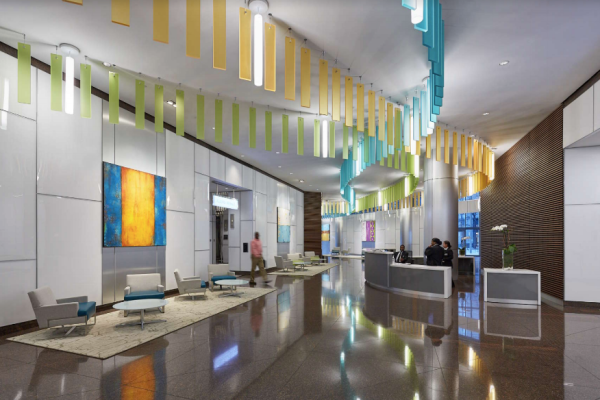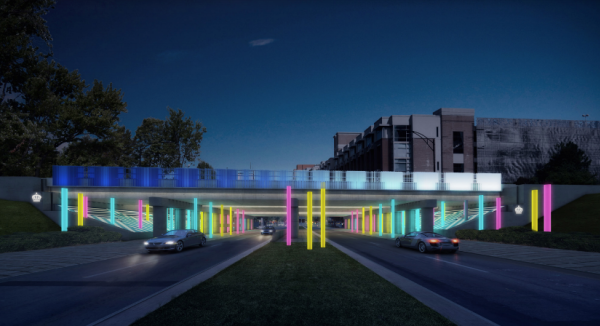Architecture as Music

The strategic use of light, pattern, and color is key for Wagner Murray Architects as the firm embarks on transforming existing public areas into entirely new spatial events. “The emotional experience of human beings within an architectural space is what it’s really about.” says principle Dave Wagner. “It has to appear effortless. The public doesn’t have to know why they feel the way that they do; the architectural elements simply have to work together harmoniously to bring about the desired effect.”
The German poet and philosopher Goethe’s famous aphorism “architecture is frozen music” is an important truth for Wagner and his firm. Illustrating this are two of their recent large-scale projects: the UNCG Pedestrian Tunnel in Greensboro, and the entrance and lobby of 101 N. Tryon in Charlotte. Both projects utilize the foundational power of illumination and color to alter existing spaces that, in earlier forms, lacked vibrancy and a strong sense of welcome.
The vaulted ceiling of the university tunnel completed in 2017, features enormous parabolic lines made by the facets of cast concrete elements strategically painted in navy blue and golden yellow. This dazzling effect draws the gaze of the visitor forward with inviting beauty. The upward shining lights dramatically heighten the coffering and the white that sets off the colorful facets which when viewed from the entrance resemble strings of delicate banners. To continue in the vein of musical analogies, the tunnel echoes the idea of counterpoint in music – defined as a harmonious relationship between lines while maintaining a degree of independence within the lines themselves. In other words, while experiencing the work, one sees contrasting patterns but quickly realizes how they relate to create a pleasing whole. “We really want to raise people’s sensibilities. Our work is a kind of intervention,” says Wagner.

In similar fashion, but on a much larger scale, the redesigned entrance and lobby of 101 N. Tryon utilizes suspended frosted acrylic rectangles to create long curving rows of pale green, yellow and cerulean. There is something sonic about these colorful rows. They resemble piano keys due to the way they wind through the long stretch of the lobby as if marks of musical notation had flown into the air and arranged themselves along the ceiling. All of this is echoed below in the glimmering surface of the highly polished floors of the building. “We’ve been told on more than one occasion that getting people to leave after the building has closed has been a challenge,” Wagner says. “This is the highest compliment for us. To know that we’ve succeeded in making a public space where people not only want to be but where they want to stay.” Large abstract paintings using the same color palette are placed strategically throughout the lobby creating yet another echo effect.

Wagner Murray’s long-time commitment to incorporating the works of other artists into their designs continues outside the lobby on the entrance of the building where a massive 250-square-foot cast glass frieze by renowned artist, Paul Housberg, gleams during the day and glows at night. Backed by 55,000 LEDs, a spectrum from rich red and sunny gold to sea-green and aquamarine captures the gaze from many different angles creating a constant focal point. “We wanted this project to work at all times of day and night and at various stages of approach,” adds Wagner. By using such a bold and arresting element, the architects are drawing on one of the great historical practices of their field. Kings and cardinals as far back as the Baroque worked closely with architects (who often had practiced as designers of the stage) to establish focal points at important junctures of the city. These elements (towers, fountains or elaborate light sources) impacted the visual experience of pedestrians and also gave them the experience that something splendid was holding the network of paths together, pulling everyone toward one beautiful source point.
Bringing in More Light
Tradition holds that the final words of Goethe were “More light! More light!”
According to Wagner “That has also been our challenge on these projects. How to bring in more light.” As the recent awardee of the Charlotte Gateway Station project, the firm has created a series of aesthetic solutions to three underpass/bridges that add both bold daylight color and colorful nighttime illumination to areas that were previously dark and somewhat forbidding. The optical metamorphosis that properly placed light and properly applied color can render to something as hard and cold as concrete is truly remarkable. Each of the three underpasses is essentially remade through the application of luminous linear patterns that both echo the simple post and lintel structure of the original bridges but also add extra dimensionality. There is also a sense of fun and of humor to these innovations. Drivers and pedestrians alike may well feel that they are entering the gateways of some futuristic city or are even seeing the electrified outlines of a traveling carnival. The fact that Wagner Murray uses terms like “event” and “ visual performance” in the descriptions of their work is appropriate. The three tunnels can be thought of as three acts in a drama of light and color, or three mysterious rooms seen in a dream. “It is the mission of the architect who seeks to impact sensibilities and make the visitor feel something special – something elevated.” says Wagner. To provoke magic with memory and emotion is one of the firm’s stated goals. Wagner Murray’s transformation of these grand entrances and portals do just that by weaving together dramatic lighting effects and powerful arrangements of color to alter the cityscape by activating the imagination.
Below: renderings of the night views of the three underpass/bridges in Charlotte redesigned by Wagner Murray


